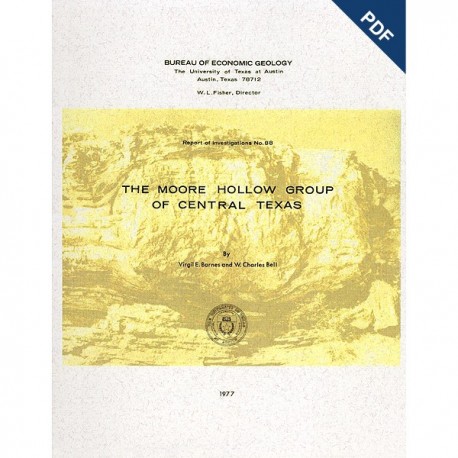Reports of Investigations
-
Books & Reports
- Reports of Investigations
- Guidebooks
- Udden Series
- Geological Circulars
- Down To Earth
- Atlases of Major Oil and Gas Reservoirs
- Texas Memorial Museum Publications
- Environmental Geologic Atlas of the Texas Coastal Zone
- Mineral Resource Circulars
- Other Reports
- Seminars and Workshops
- Handbooks
- Submerged Lands of Texas
- Symposia
- Annual Reports
- Open File Reports
-
Maps & Cross Sections
- Thematic Maps
- Miscellaneous Maps, Charts & Sections
- Geologic Atlas of Texas
- STATEMAP Project Maps
- Geologic Quadrangle Maps
- Cross Sections
- Highway Geology Map
- Energy and Mineral Resource Maps
- Shoreline Change and Other Posters
- Wilcox Group, East Texas, Geological / Hydrological Folios
- Bouguer Gravity Atlas of Texas
- River Basin Regional Studies
- Featured Maps
- Posters
- Teachers & the Public
-
Geological Society Publications
- Gulf Coast Association of Geological Societies
- Alabama Geological Society
- Austin Geological Society
- Corpus Christi Geological Society
- Houston Geological Society
- Lafayette Geological Society
- Mississippi Geological Society
- New Orleans Geological Society
- South Texas Geological Society
- GCS SEPM Publications
- Historic BEG & UT Series
The Moore Hollow Group of Central Texas. Digital Download
RI0088D
A free, digital version of this publication can be found on: Texas ScholarWorks
The Moore Hollow Group of Central Texas, by V. E. Barnes and W. C. Bell. More than 300 p., 13 figs., 24 tables, 18 plates (9 oversize), 1977. doi.org/10.23867/RI0088D. Downloadable PDF.
About This Publication
This product a three-part report. This version includes all the files (as PDF's) for the book, Part I, and Part II.
ABSTRACT
Middle and Upper Cambrian rocks and locally up to 90 feet of Lower Ordovician rocks in Central Texas, are here named the Moore Hollow Group. In ascending order, the Moore Hollow Group is composed of the Riley Formation (Hickory Sandstone, Cap Mountain Limestone, and Lion Mountain Sandstone Members) and the Wilberns Formation (Welge Sandstone, Morgan Creek Limestone, Point Peak, and San Saba Members).
A sequence of Dresbachian to earliest Ordovician faunas, as complete as any known in North America, was found during the field and laboratory work on this sequence of rocks. The mostly granular limestone of the Moore Hollow Group is composed dominantly of pelmatozoan debris; trilobite debris is abundant and in a few beds is dominant. These rocks accumulated in shallow water in a broad bay-like area.
The boundary between the Moore Hollow and overlying Ellenburger Group is identified using lithic evidence only. It is in a gradational sequence formed during continuous sedimentation, and in general the boundary is younger toward the shore. Within the Llano region the boundary between lithic types crosses the Cambrian-Ordovician boundary; consequently, Ordovician rocks are included in the Moore Hollow Group to the west and Cambrian rocks are included in the Ellenburger Group to the east.
Although the Moore Hollow Group is composed of distinctly mappable units in the Llano region, shoreward in the subsurface the carbonate rocks give way to terrigenous materials and the identity of the various units is no longer maintained. In the opposite direction in the subsurface, terrigenous units give way to carbonate rocks, a disconformity between the Riley and Wilberns Formations disappears, and dolomite becomes the principal carbonate of the Wilberns Formation.
Keywords: Blanco County, Central Texas, Llano County, Llano region, minerals, Moore Hollow, Riley Formation, stratigraphy, Wilberns Formation, petrography, petrology, San Saba County
Citation
Barnes, V. E., and Bell, W. C., 1977, The Moore Hollow Group of Central Texas: The University of Texas at Austin, Bureau of Economic Geology, Report of Investigations No. 88, 169 p.



